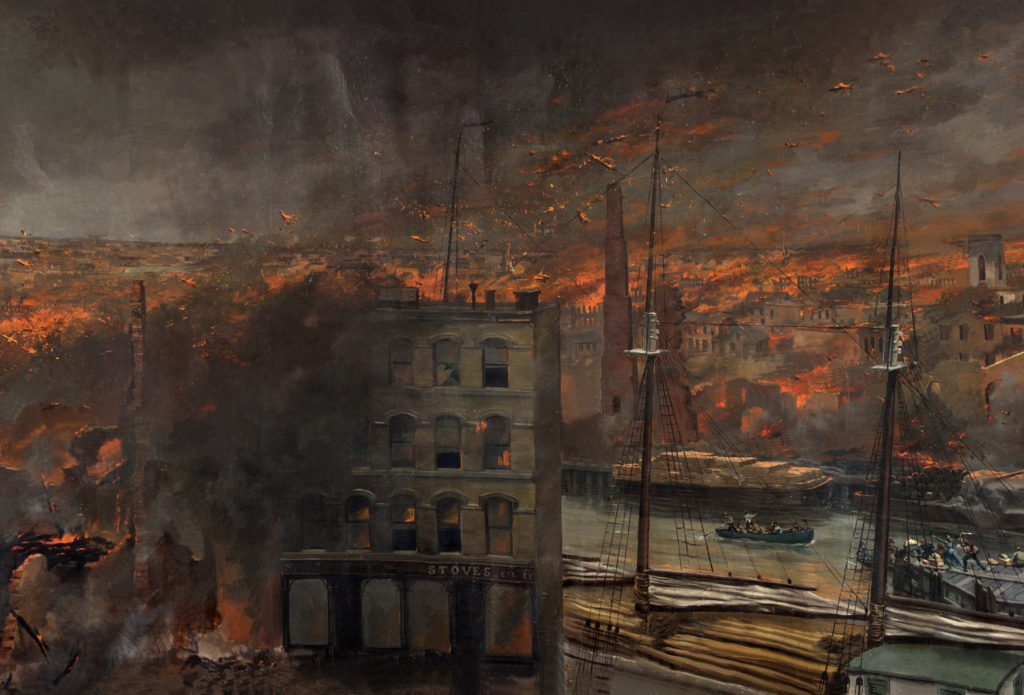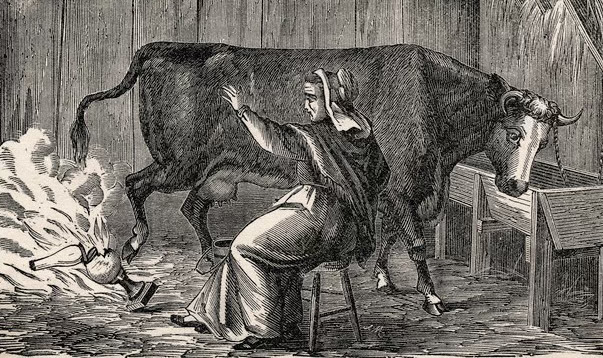The truth would have made a great story: Catherine O’Leary, successful Irish immigrant businesswoman. She had five cows in her dairy and her husband Patrick was gainfully employed as a lathe-worker.
As Catherine and Patrick slept on that dry October night in 1871, someone started a fire in their barn. The blaze grew into the Great Chicago Fire, killing 300 people, leaving 100,000 homeless and leveling all of downtown Chicago.

Instead of the truth, Chicago’s sensationalist newspapers invented a caricature to reinforce the anti-Irish prejudices of the day: Kate O’Leary the hapless shanty-Irish widow with too many children. She clumsily set a lantern next to the cow she was milking. The cow kicked over the lantern and the rest is false history.
The police inquest after the fire did not blame O’Leary — it concluded that “unknown” persons started the fire in her barn. But she had already been tried and convicted in the court of public opinion.
Amateur historian Richard Bales’ tireless research over the past few years unearthed new evidence of O’Leary’s innocence. The Chicago City Council has now adopted a resolution formally exonerating her.
“The press was eager to find Mrs. O’Leary a scapegoat as a working-class woman and an immigrant,” Ald. Edward Burke proclaimed as he introduced the ordinance in October. “They always found it comfortable to vilify Irish Catholics who had not quite assimilated into American society.”
Indeed just three years before the fire, the Chicago Evening Post said in an editorial, “Scratch a convict or pauper and the chances are that you tickle the skin of an Irish Catholic — made a criminal or a pauper by the priest and politician who has deceived him or kept him in ignorance — in a word, a savage, as he was born.”
The prejudice showed in The Chicago Times’ coverage of the fire. On October 17, a week after the fire, the newspaper called O’Leary an “old hag,” about 70 years old and “bent almost double with the weight of many years of toil and trouble and privation.”
Six weeks later, the same newspaper covered O’Leary’s testimony before the police board and referred to her as “a tall stout Irish woman with no intelligence.” The paper reported she appeared before the board with a baby and that “during her testimony, the infant kicked its barelegs around and drew nourishment from immense reservoirs.”
O’Leary’s baby, also named Catherine, begat Eileen, whose granddaughters Nancy Connelly and Lynn Cody beamed with pride as the city council cleared their great-great-grandmother’s name last October.
“Now that she’s exonerated, we can feel better,” Connelly said. “She’s probably looking down from heaven saying, `Allright!'”
Connelly and Cody confessed the notoriety of being a Kate O’Leary descendant was never really a burden.
“It was actually kind of fun,” Connelly said, noting her father and grandfather were firefighters. The city’s Fire Academy today stands on the site of the old O’Leary home — ironically one of the few buildings in Chicago to survive the fire. “In grade school, the teachers would have us get up and give our side of the story.”
The O’Leary family theory passed down to Connelly and Cody from Grandma Eileen Knight squares with Richard Bales’ new research: Ne’erdo-well neighbor Daniel “Peg Leg” Sullivan started the fire.
“He was kind of a neighborhood guy, he would come around and talk to everyone,” Connelly said. “He didn’t really have a job. He was kind of a pest actually. The McLaughlins (neighbors to the O’Learys) were having a party that night. He went there. At some point he went out to the barn, maybe to get a beer.”
That’s when Sullivan probably started the fire, said Connelly and Cody. Grandma Eileen Knight had to badger that information out of her mother, who wanted to forget about the whole incident, they said.
“She kept saying, `Mom — what’s everyone saying about the fire?'” Connelly recalled. “Her mom didn’t want to tell her. You know the Irish way — just ignore it and it will go away. I think she finally learned about it from an uncle when she was 10 or 11.”
Hounded by the unofficial blame for the death and destruction caused by the fire, the O’Learys moved from their working-class Irish neighborhood on the Near West Side to Michigan and then back to Chicago’s South Side. The O’Learys had been married in Cork, though some say Patrick was a Kerryman.
The family always resented the press caricature of Kate O’Leary as a poor Irish widow on the dole or an overburdened mother.
“[The attitude was] You know how those Irish are:they have all those little kids, they don’t take care of their property,” Connelly said. “They were actually middle-class. She had her own dairy business, separate from her husband who was a tradesman.”
The police board noted Catherine O’Leary had five cows, a horse, a calf, two tons of hay, and two tons of coal stored in an adjoining shed.
Bales, an attorney for Chicago Title & Trust, has spent the past two years transcribing the 1,000 pages of hand-written testimony from the police board’s inquest. Using his company’s property records from before the fire, he reconstructed a map showing where the O’Learys’ house, the McLaughlins’ house, and various other houses in the neighborhood must have been.
Sullivan testified that he stood at a neighbor’s doorway and saw the fire break out in O’Leary’s barn. But Bales’ map shows a two-story house between Sullivan’s alleged viewing place and the barn.
Bales found numerous other inconsistencies in Sullivan’s testimony. Sullivan testified that after he saw the fire, he ran into the O’Learys’ barn in an unsuccessful effort to try to save her cows, horse and calf. He says he fell down in the barn; got back up and ran back, the whole time yelling “Fire, fire, fire.” That’s 196 feet on a wooden leg, Bales calculates. The temperature was an unseasonably warm 79 degrees that day, windows were likely open, yet no one testified they heard him yelling, Bales notes.
“The evidence that most exonerates Mrs. O’Leary, is, in the final analysis, the most damning to Sullivan,” Bales says in the article he wrote for the Illinois Historical Journal and which he plans to expand into a book. Bales, of German and English descent, embarked on this research to solve a great mystery, he said.
But while Bales’ research points to Sullivan as the culprit — which would transfer blame from one Irish immigrant to another — other theories have been offered over the years, including a comet striking the barn.
A recent Chicago Tribune article suggests that then-18-year-old Louis M. Cohn was shooting craps in the barn with O’Leary’s son, James, age 9 at the time, and other boys. Cohn confessed 71 years later in his will to starting the fire. A 1964 book about gambling said Cohn bragged he was winning the game when he kicked over the lantern and grabbed the kitty as he ran from the barn.
The gambling story is made all the more plausible by the fact that “Big Jim” O’Leary grew up to own and operate the biggest casinos in Chicago in the early 1900s.
But the purpose of October’s resolution was not to fix blame for the tragic fire that forever changed the face of Chicago — it was to clear Catherine O’Leary.
“Mrs. Kate O’Leary and her husband Patrick are innocent of any blame for the fire that raged behind their home,” Ald. Burke proclaimed as aldermen prepared to pass the ordinance.
Teased by aldermen from the city’s other ethnic communities about why the Irish would go through such efforts to posthumously pardon one of their own, Burke laughed with Mayor Richard M. Daley and responded, “The Irish are ready to absolve each other even if it’s after 120 years.” ♦


An excellent article and in effect shows how much Chicago changed over the years. It must have had a very small population at the time of the “”Great fire.”” When I came to the U.S Chicago had the largest Catholic Archdiocese in the country. Some years later there was a statement in a major newspaper which said that if you thought Warsaw was the largest Polish city in the world, you would be wrong. It is Chicago. The City of Angels (Los Angeles) is now the largest Catholic Archdiocese in the U.S.
Overall, it”s a very educational article.